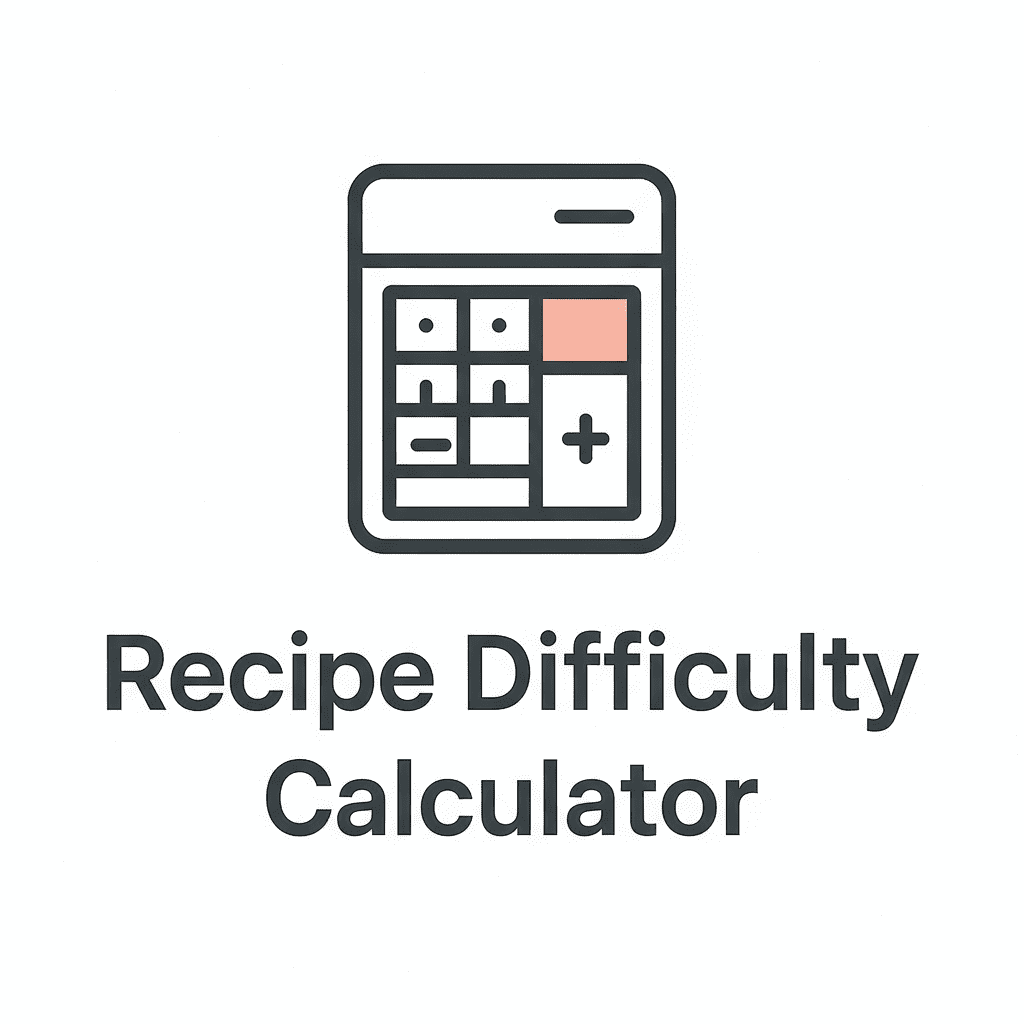Recipe Difficulty Calculator – Rate Cooking Complexity
Determine Recipe Skill Level
Not sure if a recipe is right for your skill level? Our intelligent calculator analyzes multiple factors to give you an accurate difficulty rating.
Why does recipe difficulty matter? Choosing recipes that match your skill level builds confidence, reduces kitchen stress, and ensures delicious results every time!
Recipe Information
Technique Analysis
Select all techniques required in this recipe:
Equipment Requirements
Select any specialized equipment required:
Additional Factors
Recipe Difficulty Assessment
Personalized Recommendations
Based on your recipe analysis, we recommend…
Find Beginner-Friendly Recipes
Just starting your cooking journey? Here’s what to look for in beginner-friendly recipes:
Beginner Recipe Characteristics:
• Fewer than 8 steps/instructions
• Minimal specialized equipment (basic pots, pans, knives)
• Forgiving techniques (no critical timing windows)
• Short preparation time (under 30 minutes)
• Common, easily available ingredients
Perfect Beginner Recipes to Try:
• Scrambled eggs with toast
• Pasta with simple tomato sauce
• Sheet pan roasted vegetables
• Simple stir-fry with pre-cut vegetables
• No-knead bread
Skills to Master First:
• Knife safety and basic chopping
• Understanding heat levels (low, medium, high)
• Reading and following recipe instructions
• Basic seasoning (salt, pepper, herbs)
• Pan frying and sautéing
Technique Analysis
Understanding cooking techniques is key to mastering recipe difficulty:
Knife Skills Progression
Beginner: Chopping, slicing
Intermediate: Dicing, mincing
Advanced: Julienne, brunoise, chiffonade
Tip: Practice with inexpensive vegetables like potatoes and carrots before moving to more expensive ingredients.
Heat Control Mastery
Beginner: Boiling, simmering
Intermediate: Sautéing, pan-frying
Advanced: Braising, caramelizing, tempering chocolate
Tip: Learn to recognize visual cues (bubbles, color changes) rather than relying solely on timers.
Timing & Coordination
Beginner: Single-component dishes
Intermediate: 2-3 components with staggered start times
Advanced: Multiple components with precise timing coordination
Tip: Read the entire recipe before starting and create a timeline for when to begin each component.
Equipment Requirements
Having the right tools can make or break your cooking experience:
Essential Beginner Equipment:
• Chef’s knife (8-inch)
• Cutting board
• Two saucepans (small and medium)
• Skillet (10-12 inch)
• Mixing bowls
• Measuring cups and spoons
Intermediate Equipment Upgrades:
• Kitchen scale (for baking accuracy)
• Instant-read thermometer
• Food processor
• Dutch oven
• Quality baking sheets
Advanced/Specialized Equipment:
• Stand mixer
• Immersion blender
• Sous vide machine
• Mandoline slicer
• Pastry bags and tips
• Pressure cooker
Time Assessment
Time pressure is a major factor in recipe difficulty:
Active vs. Passive Time
Active time: Hands-on cooking, chopping, stirring, monitoring
Passive time: Baking, simmering, marinating, resting
Pro Tip: A recipe with 2 hours total time but only 30 minutes active time is often easier than a 45-minute recipe with constant attention required.
Critical Timing Windows
Some recipes have moments where timing is crucial:
• Candy making (soft ball, hard crack stages)
• Soufflés and meringues (must be served immediately)
• Pasta (overcooking ruins texture)
• Steak (resting time affects juiciness)
Beginner Tip: Avoid recipes with critical timing windows until you’ve mastered basic techniques.
Multitasking Requirements
Managing multiple components simultaneously increases difficulty:
• Beginner: 1-2 components
• Intermediate: 3-4 components with staggered timing
• Advanced: 5+ components with precise coordination
Strategy: Prepare components in advance when possible, and use timers to stay organized.
Skill Recommendations
Build your cooking skills progressively with these targeted recommendations:
For Beginners (Level 1-3)
• Master basic knife skills
• Learn to properly season food
• Practice pan frying and sautéing
• Understand oven temperatures
• Start with simple, forgiving recipes
For Intermediate Cooks (Level 4-6)
• Learn sauce-making techniques
• Practice braising and stewing
• Master timing for multiple components
• Experiment with different cuisines
• Learn to substitute ingredients
For Advanced Cooks (Level 7-8)
• Master pastry and baking techniques
• Learn fermentation and preserving
• Practice precision temperature control
• Experiment with molecular gastronomy
• Develop your own recipes
How to Choose Recipes for Your Skill Level
The key to cooking success is choosing recipes that match your current skill level while gently pushing your boundaries.
Here’s a simple formula: Your Skill Level + 1 = Ideal Recipe Difficulty
This means if you’re a beginner (Level 2), look for recipes rated Level 3. This will challenge you without overwhelming you.
Building Cooking Skills Progressively
1. Start Simple: Master basic techniques before moving to complex ones.
2. Practice Regularly: Cook at least 3-4 times per week to build muscle memory.
3. Learn from Mistakes: Every kitchen disaster is a learning opportunity.
4. Watch and Learn: Use video tutorials to see techniques in action.
5. Teach Others: Explaining techniques to someone else reinforces your own understanding.
Frequently Asked Questions
Beginner-Friendly Recipe Collections
Ready to start cooking? Here are some perfect beginner-friendly recipe collections to get you started:
30-Minute Meals
Perfect for busy weeknights, these recipes require minimal prep and cooking time.
Examples: Stir-fries, sheet pan dinners, pasta dishes
One-Pot Wonders
Minimal cleanup and simple techniques make these ideal for beginners.
Examples: Soups, stews, skillet meals
No-Bake Desserts
Perfect for building confidence in the kitchen without worrying about baking times and temperatures.
Examples: No-bake cheesecakes, refrigerator cookies, chocolate bark
Breakfast Basics
Start your day with simple, forgiving recipes that build essential skills.
Examples: Scrambled eggs, pancakes, oatmeal, smoothies

